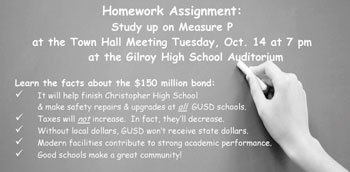School officials pushed the election envelope at a poorly
attended town hall meeting.
School officials pushed the election envelope at a poorly attended town hall meeting.
The Gilroy K.I.D.S. – Keep Improving District Schools – campaign took out an advertisement in the newspaper to notify community members about a recent forum on Measure P, a $150 million school facilities bond. Gilroy High School Principal James Maxwell also sent out an invitation to 1,700 high school families via School Loop, an online portal, and left phone messages, in English and Spanish, with each of the school’s 2,500 students’ families.
The invitation enumerated several facts about the measure, that it will help finish Christopher High School – scheduled to open in August 2009 – and that state funds will not be available until the district comes up with a local match. But the invitation slanted toward advocacy when it listed how the new measure will decrease taxes, that modern facilities contribute to strong academic performance and how good schools make a great community.
“They’re coming right to the edge of the ethical precipice,” said Charles Dunn, political analyst and dean of government at Regent University in Virginia Beach. His former political posts include serving as a special assistant to the Minority Whip of the United States House of Representatives, deputy director of the Republican Conference in the House and chief of staff to a U.S. Senator from New York.
“If I were on the school board or if I were principal of the school, I wouldn’t do it,” he said of the decision to hold the meeting at a school facility and have district officials give a presentation with an unintended, but built-in, bias toward passing the bond. “They need to be squeaky clean, above and beyond reproach.”
And staff simply crossed the line when they attempted to display “Yes on P” signs at the meeting, held on school property, said Mark Zappa, Gilroy business owner and taxpayer advocate.
Superintendent Deborah Flores personally invited Zappa to attend the meeting and present the opposition to Measure P. Skeptical that the meeting would turn into a rally promoting P, Zappa was reassured by Flores’ invitation, he said. But before he even made it into the Gilroy High School auditorium, he stumbled across district staff posting promotional materials in the foyer, he said.
He notified Flores who immediately ordered the signs to be put away. But Zappa doubted the impartiality of the meeting had he not shown up.
“Do I think it would have been fair and balanced had I not shown up?” he said. “Probably not. It would have been a campaign rally. It’s hard to say what would have happened had I not been there.”
He did, however, acknowledge that Flores made a genuine attempt to present the opposing point of view. After her presentation on school facilities over the past 10 years and recent academic gains, Zappa was given a chance to speak.
But even if district officials tried to be impartial by inviting Zappa, Dunn said the meeting wasn’t fair from the start. The superintendent may not have come out and said “Vote yes on P,” but the district would have been better off selecting two people who weren’t affiliated with the district to represent support for and against the measure, he said.
“While I would give her (the superintendent) credit for inviting someone from the other side,” Dunn said, “they stacked the deck.”
Although district officials weren’t waving “Yes on P” signs, they clearly have a vested interest in the passage of the bond, he said. And when one taxpayer advocate, like Zappa, has to take on the public school institution, a long-standing establishment that has the power of voices on its side, the opposing voice can be stifled, Dunn said.
During his speech, Zappa focused on bond language he called misleading. Since the school board decided to place the bond on the ballot, one of the selling points has been that it will kick in only after the current bond, which taxes property owners about $71 per $100,000 of assessed home value per year, sunsets. Measure P proposes a $60 tax for every $100,000 assessed home value, per year. The net result would mean homeowners pay about $11 per $100,000 of assessed value less on their taxes.
“They’re saying a yes vote will lower taxes,” Zappa said. “That is misleading and basically a lie. Measure P is creating a new tax. If Measure P did not exist, taxes would go down by $70 per $100,000, rather than just $10 (per $100,000).”
Zappa said the other bullets on the invitation addressing the effects of facilities on academic performance and communities were also controversial.
Using district e-mail systems and telephones to urge the passage of a ballot measure is illegal, according to California’s educational code. However, notices providing fair and impartial facts about the measure are allowed.
Trustee Jaime Rosso recognized that a few of the points made on the invitation distributed through the high school e-mail network may have been editorializing.
“They were probably a little fuzzy,” he said. “But they’re pretty basic statements, common sense statements. They’re not saying to vote yes on P.”
And at the actual meeting, the opposition had ample time to speak, Rosso said.
The notice may have been inappropriate but the district didn’t break the law, said Kris Vosburgh, executive director for the Howard Jarvis Taxpayer Association, a legal and political watchdog group that opposes higher taxes.
“It’s very common for districts to push the envelope, to go right up to the line and think no one is watching,” Vosburgh said. “And very often they get away with it. There’s a big difference between what’s right and what’s legal.”
For example, a Valley Transportation Authority watchdog group recently called into question the ethics of the VTA’s campaign to pass their own tax.
Districts will present information highlighting only the advantages of a measure and rarely delve into the pitfalls, Vosburgh said. But they avoid blatantly endorsing the measure.
“They do everything but tell people how to vote,” he said.
With unemployment rates creeping higher and record foreclosures, Vosburgh was doubtful that many public agencies would even see success in November.
“They’re picking the worst possible time to push something that will result in higher property taxes,” he said. “A lot of people who thought they had a slam dunk in getting bonds and taxes approved will be unpleasantly surprised. This could be the election where people just say ‘I’ve had enough.’ ”
Historically, taxes that require a 55 percent passage rate – like Measure P – pass 90 percent of the time. The tradeoff is that they require a citizens oversight committee to monitor expenditures, a committee that Zappa said is a joke and, in actuality, has little say in the matter. Taxes that require a two-thirds vote pass about 60 percent of the time.
But Flores and board members have heard a different story from the community.
“There’s a lot of support for Measure P,” Flores said. “People understand that this is the only way we can fund schools.”
Flores said she tried to conduct a balanced meeting and that’s why she invited Zappa to speak on behalf of the opposition. She said the “Yes on P” signs displayed at the beginning of the meeting were a result of an honest misunderstanding.
“We tried our best to be impartial and factual, but it’s a difficult walk,” she said. “I’ve had to monitor myself. I’m very emotionally invested in this.”













